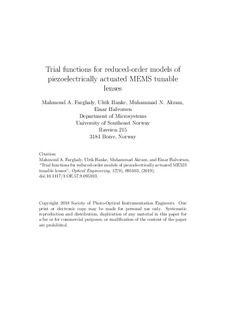Trial functions for reduced-order models of piezoelectrically actuated microelectromechanical systems tunable lenses
Journal article, Peer reviewed
Accepted version
Permanent lenke
http://hdl.handle.net/11250/2589679Utgivelsesdato
2018Metadata
Vis full innførselSamlinger
- Institutt for mikrosystemer [520]
- Publikasjoner fra CRIStin [3401]
Sammendrag
Piezoelectrically actuated microelectromechanical systems (MEMS) lens structures can be composed of a clamped square elastic diaphragm partially covered with a thin piezoelectric film leaving a circular transparent region to form a lens pupil. To model these lenses’ linear static optoelectromechanical performance, the displacement can be approximated by a linear combination of basis functions, e.g., weighted Gegenbauer polynomials that satisfy clamped boundary conditions along the diaphragm edges. However, such a model needs as much as 120 degrees of freedom (DOFs) to provide a good approximation of the lens optical performance. To improve on this, we here consider approximating the deflection by an expansion using piecewise smooth functions that have different forms in the pupil and the actuator regions. We use exact solutions for the elastic plate differential equation over circular and annular subdomains, and weighted Gegenbauer polynomials in the remaining region. The latter enforces the boundary conditions. We have found that the larger the diaphragm area with exact plate solutions is, the lower is the number of DOFs needed to predict mechanical and optical quantities accurately. For example, a model with 10 DOFs achieves accuracies of 5.1% and 2.1% for RMS wavefront error and reciprocal F-number, respectively, for all pupil openings of interest.
Beskrivelse
One print or electronic copy may be made for personal use only. Systematic reproduction and distribution, duplication of any material in this paper for a fee or for commercial purposes, or modification of the content of the paper are prohibited.
